CHEN HONTSUNG Chief Instructor
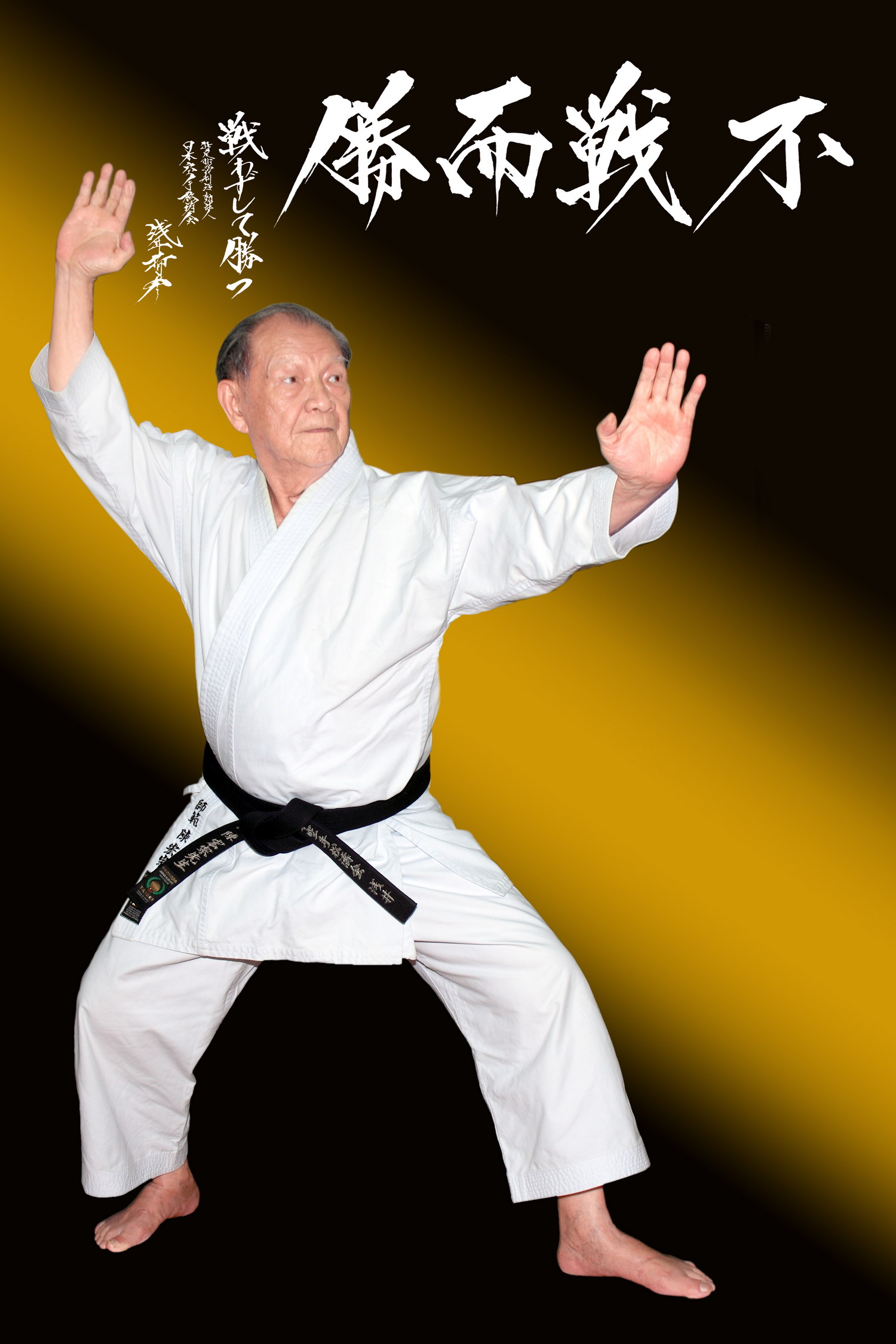
In order to pass on the wonderful karatedo that I inherited from Asai Shihan, I have accepted and taken on the responsibility of the I.J.K.A. Chief Instructor position for him. I would like to follow the lead of Asai Shihan, who showed no end to his training, and to continue working on everyone's karate skills and kokoro, together with you.
Nowadays it is easy to watch karate footage on the Internet, and it seems the attitude toward learning karate has become too relaxed. It is almost as if people think they can just superficially imitate the forms from these images and they don't need to learn from a master anymore - but that is not the case. You can't learn real martial arts from video footage. A 20 year-old's karate is different from that of someone who is 50, and if you use your muscle incorrectly you can seriously injure your body. As Asai Shihan used to say, "for those who come to learn, I will teach you all I have." The door to the main dojo is open anytime.
Footage
IJKA総本部道場にて撮影
Chin Sensei is carrying on the "flexible body technique," something Tetsuhiko Asai adovocated. Movements are sharp, and gentle on the body - this is healthy karate. This is the core of Asai-ryu Karate.
The Karate Life of Chief Instructor Mr. Chen Hung-tsung Chap. 1
49 years ago, Master Asai left Japan to introduce Karate to the world. The first stop was Taiwan, because of the experience he had there before becoming an instructor for the Hawaii Karate Association.
Mr. Chen was an avid martial artist when he first met Master Asai at the age of 35 (see photograph). He was already a 3 Dan in Japanese Kendo and Judo and a master of the Chinese weapon, the 7-joint whip. He was also an assistant chief instructor for the White Crane Fist.
Upon hearing that the karate master Tetsuhiko Asai was coming from Japan, around 10 of the senior pupils of the White Crane Fist, Mr. Chen’s training mates, waited with anticipation. When master Asai finally arrived in Taichung City, the students, learning karate for the first time, practiced feverishly. The exchange of martial art techniques continued well into the night every day.
They first demonstrated the White Crane Fist, and Master Asai demonstrated his karate. The demonstration of kumite with Mr. Chen caused a loud racket from other students. Mr. Chen feared that they were jeering Master Asai and starting a riot, but in fact it was the opposite ? Mr. Chen saw they were blushing with excitement and saying:
“I’ve never seen Tsuki and Keri that fast!”
“How can we practice his waza?”
“That is beyond human capability!”
The students then asked Master Asai if they could study under him to which he agreed.
For one month before he left for Hawaii, the students came early in the morning before work and again after work and practiced until midnight. They used the school ground where Mr. Chen was a vice principal and even though they didn’t have karatedogi (karate uniform), that didn’t deter them from their training as they practiced in their own clothes. They showed an intense drive to learn and train. (see photograph)
Some of the training included the Keri (kicking) practice of wearing a heavy iron geta sandals (500 times each leg), and there was the 2 Dan renzoku tobigeri (multiple jump kick) around the 150-meter school ground. If the kick was too low they got a slap with a shinai (bamboo sword) on the backside from Master Asai. They practiced Tsuki (punching) 300-500 times each time - indeed even Mr. Chen later reminisced, saying that it was indeed a very tough training, “but everyone practiced with pure joy.”
After a month Master Asai had demonstrated almost all the basics of karate and left for Hawaii. The senior pupils of the White Crane Fist promised they would keep practicing during the 5 years Master was away, and should the time come for Master to spread karate further in Taiwan, they would do everything to help. Master promised in return that he would come back to Taiwan after the 5 years. It was a firm promise between butoka (martial artists).
When Master Asai was in Hawaii, Mr. Chen led his fellow students of the White Crane Fist in karate. Almost everyday he would send Master Asai pictures of them practicing and asked him questions and advice on their forms such as kihon (the basics), keri (the kick), uke (the block) and tsuki (the punch). The “distance learning” continued for 5 years. (Master Asai would sit at his desk whenever he could find the time, spreading out the pictures, and write his letter back to Taiwan.)
After Master Asai left, Mr. Chen followed his practice instructions for 5 years, even when no one came. He would practice from 6-7 in the morning before work and 6-7 after work. With the iron geta he went around the school ground doing ren geri (multiple kicks), followed by kataashi geri (one-leg kick) 1000 times and tsuki 1000 times. From around 8 pm to about 4 in the morning, he would teach the White Crane Fist at various locations telling the students they should anticipate a great karate sensei coming in 5 years.
Five years passed and Master Asai left Hawaii to return to Taiwan, leaving his Hawaiian students (despite their pleas for him to stay longer) to make good on “the promise he made.”
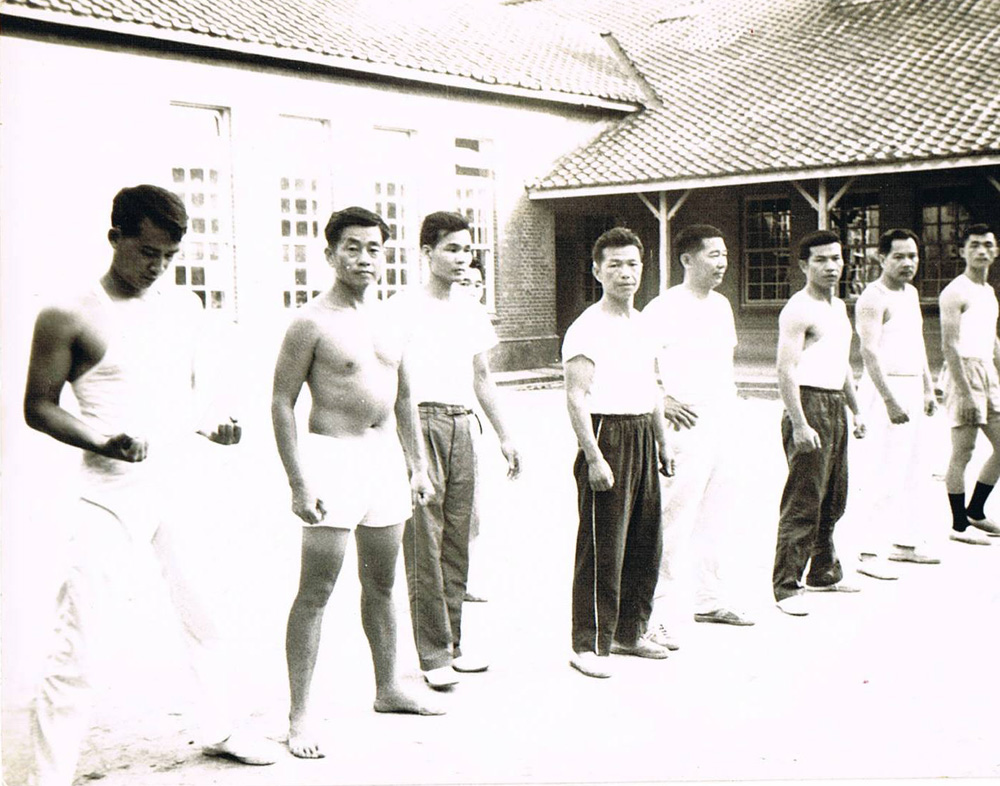 High-ranked White Crane Fist students (Mr. Chen the fifth in from the right) |
 Mr. Chen (on the left) demonstrating the White Crane Fist for Master Asai |
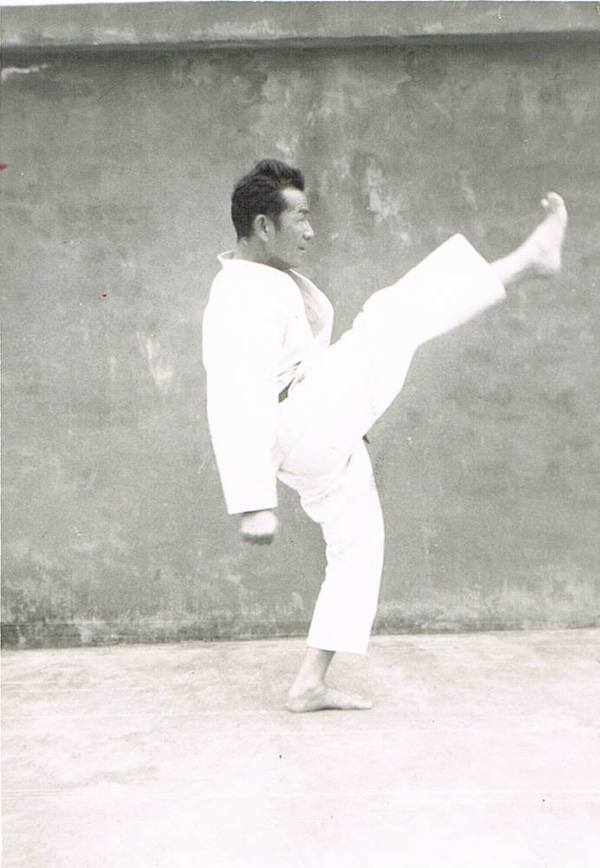 Mr. Chen’s Maegeri (front kick) shot for his “distance learning” |
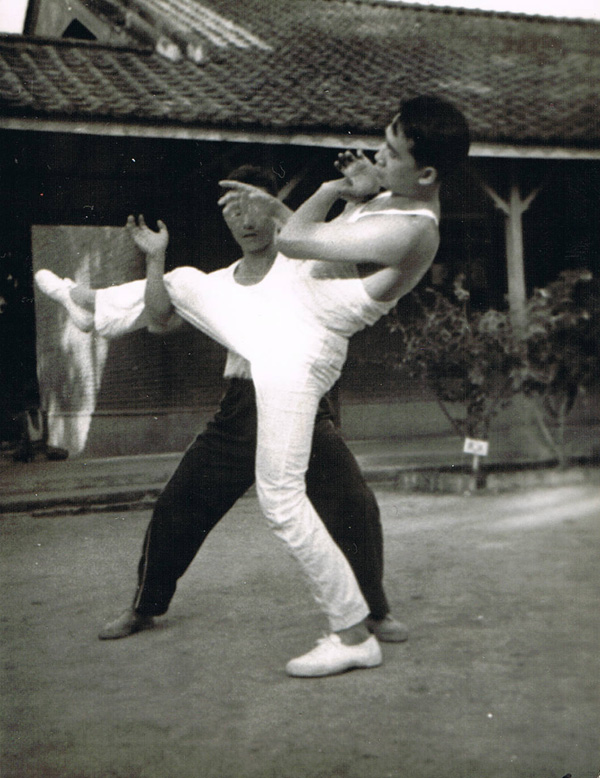 Mr. Chen (facing front) demonstrating the White Crane Fist |
 Mr. Chen (on the right) demonstrating the White Crane Fist sekkinn waza (the close combat technique) |
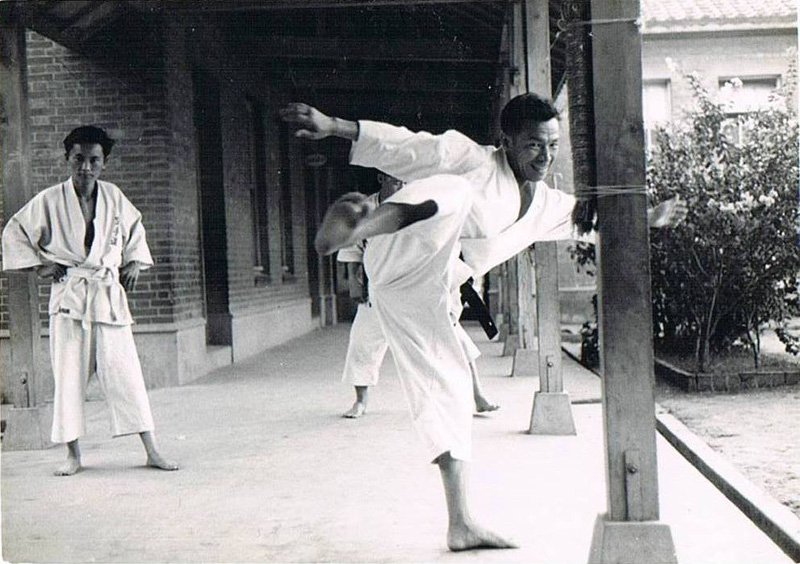 まきわらで廻し蹴りの練習 陳先生 (通信教育用写真)(当時35〜40才) |
The Karate Life of Chief Instructor Mr. Chen, Hung-tsung Chap. 2
The city of Taichung, the hometown for Mr. Chen, is where Taiwanese Karate was founded.
During the 5 years Mr. Chen took the lead in teaching, Karate attracted many people’s attention for his way of strict self-training and became increasingly more popular.
The number of disciples grew so large that even though Mr. Chen’s senior disciples were also teaching there was still a shortage of instructors. Still, karate spread from Taichung to the cities of Chinsuei, Salu, Yuanlin, Tsanghwa, Chiayi, Tainan, Kausung and Ping-tong to the South, and the cities of Hsinchu, Taoyuan, Taipei, and Hualien in the North. It also reached many universities, as there was a surge of people wishing to participate.
At the time, some of the disciples suggested Master Asai should start a business, saying “Sensei, you could make a lot of money doing this, considering that there are a few hundred disciples in one single dojo. It has already cost a lot for Sensei to build a dojo in every city and in addition to that there are the monthly rents and maintenance fees, the traveling and lodging expenses for the 7 instructors from Japan, plus salaries for them and the dojo employees - all very costly. With Sensei’s highly practiced Karate skills, this could be a personal enterprise.” To this, Master Asai promptly replied: ”For Taiwan, for being the country of my wife, I am teaching and promoting the skills of Karate. I am going to establish a public institution to train instructors.”
Mr. Chen agreed and helped Master Asai to establish the Karate Committee in cities across Taiwan with karate enthusiasts. After Master Asai used up his savings from the 5 years of teaching in Hawaii together with the earnings of his wife from all kinds of part-time jobs, 10 dojos were established across Taiwan.
Mr. Chen and Master Asai went teaching from dojo to dojo, demonstrated in gymnasiums and on TV, taking every lesson and demonstration seriously. Because they didn’t have enough funding they would often travel on Mr. Chen’s motorcycle, with Master Asai sitting on the back, for long distances between cities under the intense sun. (For perspective: it takes 6 hours from Taichung to Taipei.)
They worked in this fashion without any salary or compensation. With so many students it may seem there should be a lot of income, however for such a big endeavor as disseminating Karate in Taiwan, expenditures added up and exceeded Master Asai’s resources.
Mr. Chen was a vice principal of a school at the time, however since he traveled back and forth with Master Asai for Karate everyday it interfered with his profession resulting in many missed days. He was very close to retirement but he decided to leave the school early and gave up his pension. He then became wholly devoted to Master Asai with all his spirit. Together they were a very good combination, where Master Asai showed the skills and Mr. Chen continuously translated Master’s every word.
One other reason why Master Asai devoted himself so much to Taiwan was because, as he used to say happily,“ Taiwanese ability in karate is excellent and they are able to do what they are taught - and are very enthusiastic learners.”
After 2 years, to heighten the level of Taiwanese Karate, Master Asai thought an All Taiwan Karate Association should be established above the municipal committees. He again committed the necessary expenses and went through careful preparations with Mr. Chen. When the election day came for the Taiwanese Karate Association, the presidents and directors from all the interested Karate Committees in Taiwan gathered in the city of Taipei. Among them was a wealthy person with many connections, who brought along his own company employees on several buses. As they all wrote down the man’s name at the election he was elected as the president of the Taiwanese Karate Association, leaving people astonished and speechless.
It was beyond comprehension ? after all the sweat, tear, effort and expense, the hard working city presidents, directors, and members of Karate municipal committees, as well as Mr. Chen, who really understood and practiced karate, couldn‘t be elected, but a man knowing nothing about karate was elected as the president by his own employees also knowing nothing about karate and merely following his orders.
That happened during a time of martial law in Taiwan.
Still, Master Asai wished Taiwanese Karate to be developed through Taiwanese’s own hands, and decided about 2 more years were needed to have the instructors educated to teach karate. Master Asai continued teaching karate with Mr. Chen always by his side. At that time, in addition to the usual teaching in dojos, Master Asai gave special training for instructors, and trained them everyday with Mr. Chen’s translation.
The president of the Taiwanese Karate Association was annoyed and angry at the free training, and issued a document prohibiting all Asai Tetsuhiko’s Karate activities within Taiwan. (The document is archived.)
Despite men with evil like that, it was still far less than all those being good.
People with higher positions at the Immigration Office laughed at the document and said “the Karate organization is a civil entity which has no right to forbid a foreigner to do anything. The Taiwanese government is very much grateful to what Master Asai has done to Taiwanese Karate. Please do anything to help us further develop Taiwanese Karate.”
Encouraged by that, Master Asai stayed 2 more years and did his best with Mr. Chen to educate the Karate instructors in Taiwan.
Master Asai was impressed with Mr. Chen for always giving precise instructions on karate movement, as he was a martial artist and a teacher by profession. Having zealousness for karate, Mr. Chen with his 2 sons went to the Japanese head dojo directed by the late Nakayama sensei, to where Master Asai belonged, and participated in the instructor practices. Nakayama sensei said to Mr. Chen “Why don’t you stay in Japan and teach Karate?”
The president of Taiwanese Karate Association was annoyed by Mr. Chen’s gradual progress in karate. He used his connections and turned in a secret letter to the government saying, “Asai Tetsuhiko was close to the Chinese Communist Party, and was trying to persuade Taiwanese youths to be lead by the Chinese Communist Party.” (The document is archived)
The rumor got around and was widely circulated.
Martial law was still in place in Taiwan, and people were afraid of being arrested. The president, who entered the organization established by Master Asai and Mr. Chen, and his senior disciples and instructors were teaching karate in their own society, attended the Asian Karate Convention and having high achievement and winnings, had taken a lot of rewards from the government.
The remaining disciples of Mr. Chen were angered by this. Master Asai said with a very straight face, “I graduated from Takushoku University, and that’s why I am full of pioneering spirit. Since we developed Taiwanese Karate, just this is fine with me. The Taiwanese Karate turning out to be good or bad is the responsibility of the Taiwanese. With a person like that president and all his privileges, who knows, Taiwanese Karate might become better.”
From then on, Mr.Chen learned karate from Master Asai with much more depth. The two also practiced and studied the White Crane Fist and Master also learned from Mr. Chen the 7-Joint Whip. They exchanged with other Taiwanese martial artists and learned the skills of other Chinese weapons. With the many educated instructors in Taiwanese karate, Master Asai was relieved and could depart for world-wide dojos who waited for 5 years while he was in Taiwan. Within the next few years, he would become Master Asai in about 70 countries around the world.
After Master Asai left Taiwan, Mr. Chen was kept suppressed by all kinds actions taken by the president. The advertisements of his dojo were taken down, and the disciples were viciously harassed so as to stop them from going to the dojo. During the past 30 years, with his son Chen Hsing-Kwei, Mr.Chen continued to face similar hard times. However, Mr.Chen did not give up on teaching Asai Karate. While teaching around the world, Master Asai was fully aware of it, and so to continue to support Mr. Chen and sustain the high level of Taiwanese Karate, he frequently visited Taiwan to teach.
In these few years, Taiwan became more democratic, and so did the world of Karate.
The disciples gradually returned, and many of them became great martial artists by the hands of Mr. Chen. One of the grand-disciples established another Taiwan-wide karate organization that supported the travelling and teaching expenses for Master Asai. During this time, Mr. Chen was also visiting the Gojuryo of Karate in Japan teaching the White Crane Fist. There were people from Japan wanting to learn from him, and he actively established friendly exchanges with other style of karate.
In June 2006, disciples from all over Taiwan gathered in Taipei to celebrate Master Asai’s birthday - which became his last. It seemed to be God’s will to have this kind of union of the presidents and/or their representatives from all Karate Committees, for him to have a chance to give a farewell to everyone whom he had provided care for during the last 50 years. At the gathering Mr. Asai said to the disciples and grand disciples that Mr. Chen was always the leader, and what Taiwan Karate had become was the manifestation of his achievement through his devotion to teaching karate. A few days before Master Asai passed away, his wife's secretary, that “it was great to have Mr. Chen be responsible for Taiwanese Karate. He has done a great job.” Also said to his wife Keiko that “it has been nearly 50 years - Mr. Chen’s Karate life is sufficiently qualified for the 9th Dan, and it’s been 10 years since he obtained the 8th Dan, Let’s award him with the 9th Dan.”
That became his will, and after he passed away among his belongings there was a Certificate of the 9th Dan for Mr. Chen written personally by Master Asai.
Mr. Chen, being the Chief instructor for IJKA, because of both his achievement and almost 50 years interpretation of Karate for Master Asai, and training under him, no one will ever know Asai Karate more than he does.
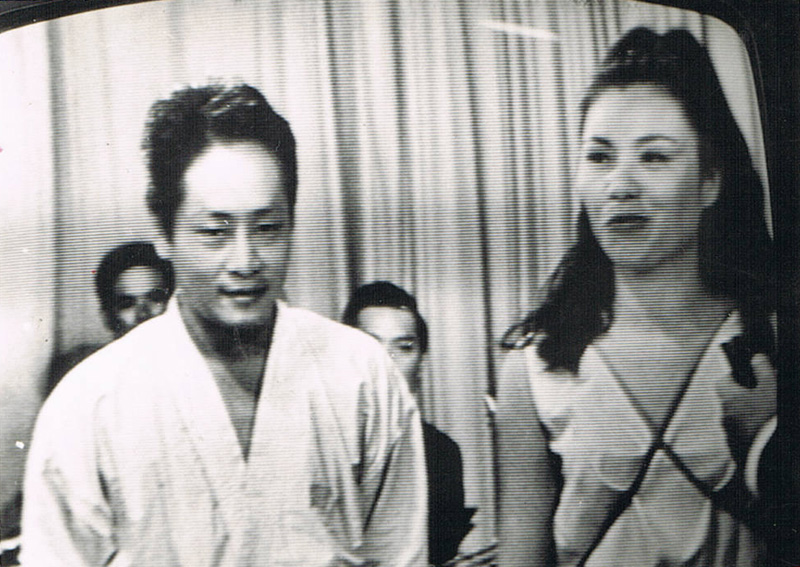 台湾各TVで演武しミセス浅井が解説 |
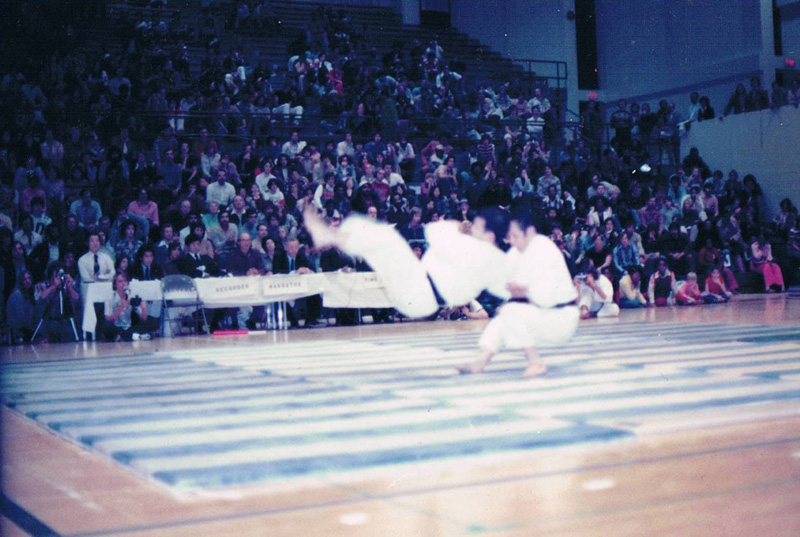 台湾各地で空手を紹介する為に演武するマスター浅井 |
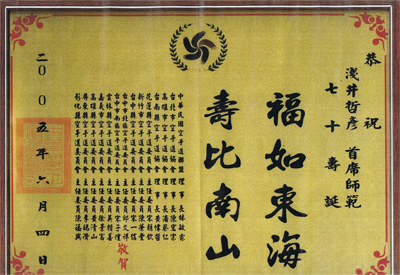 最後の誕生日パーティーに台湾全土の弟子や孫弟子達がお祝いにはせ参じた |
 殺到する大勢の会員達 |
 白鶴拳の技を披露する陳宏宗先生(左)?(当時35才)と弟の陳宏達 |
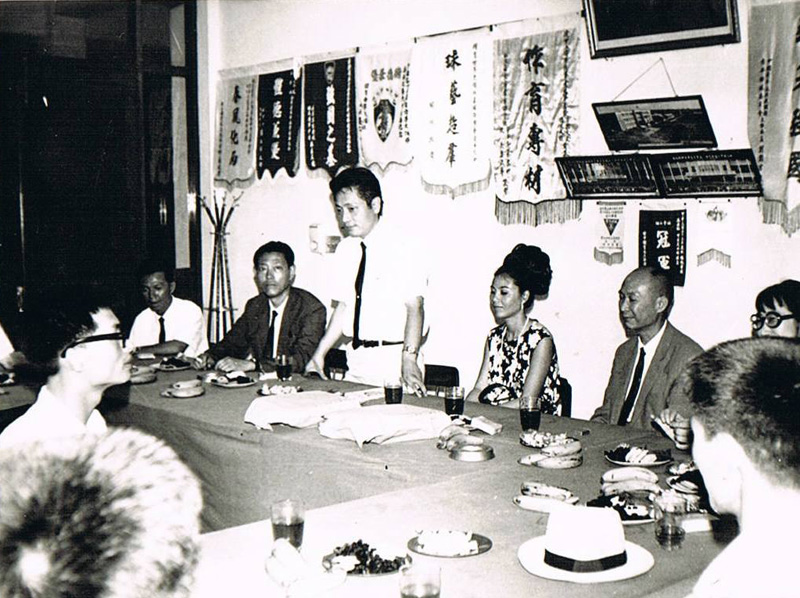 台湾台中市中興大学の校長先生の歓迎を受け、挨拶するマスター浅井。その日開設した空手部は今日迄40年間続いている |
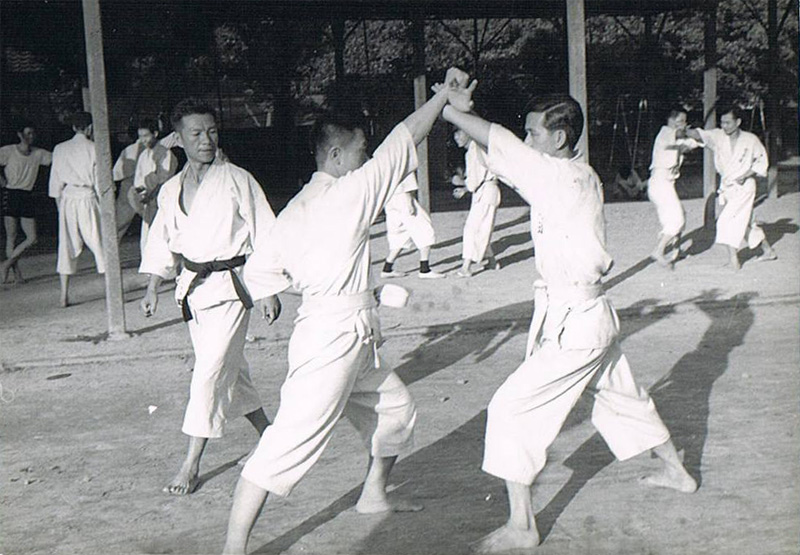 マスター浅井 ハワイから台湾へ。台湾空手創始! 校庭にて指導する陳先生(黒帯) 当時40才 |
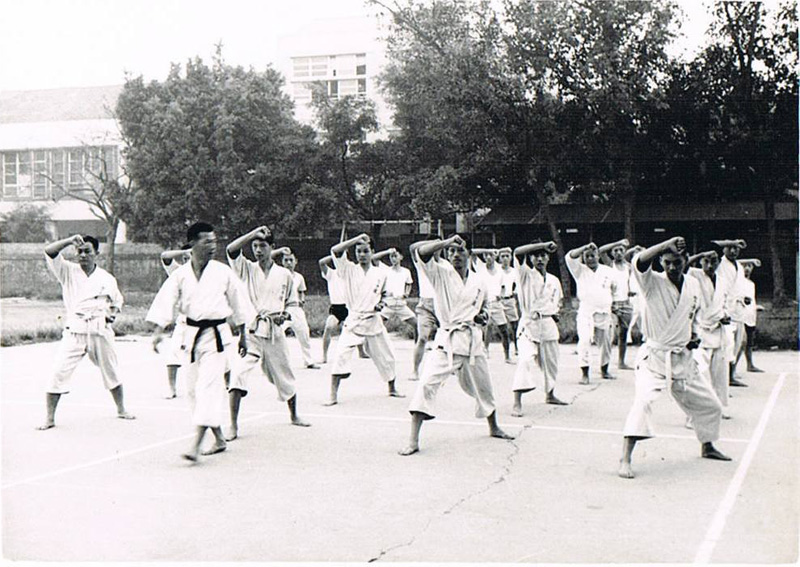 まだ道場ができない前に集まった練習生達 最前にて指導する陳先生 |
